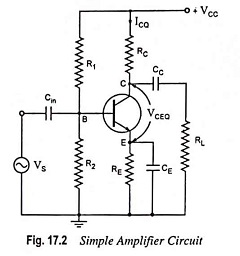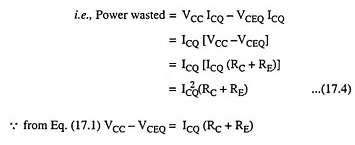Difference between Voltage Amplifier and Power Amplifier:
The Difference between Voltage Amplifier and Power Amplifier are discussed below
The primary function of the voltage amplifier is to raise the voltage level of the signal. It is designed to achieve the largest possible gain. Only very little power can be drawn from its output.
The voltage gain of an amplifier is given by the expression Av = β RC/Rin. So in order to achieve high voltage amplification (i) transistors having thin base i.e., the transistors with high β (exceeding 100) are used (ii) input resistance Rin is kept quite low in comparison to collector load RC and (iii) to permit high collector load, which is necessary to provide high voltage gain, the voltage amplifiers are always operated at low collector current (of the order of 1 mA). R-C coupling is preferred for coupling various stages of voltage amplifiers because it is smaller in size, light in weight, cheaper in cost and it occupies less space.
A power amplifier is required to deliver a large amount of power and as such it has to handle large currents. So in order to achieve high power amplification, (i) large sized power transistors are used in order to dissipate the heat produced in transistor during operation, (ii) transistor having thick base (i.e., transistors with comparatively smaller β) are used in order to handle large currents (iii) transformer coupling is used for impedance matching and (iv) collector resistance is made low. If its value is high, power losses in the collector resistor will be enhanced. Moreover, voltage drop across it will increase and, therefore, operating voltage will be reduced. This is the reason that low collector load resistance is used.
The noteworthy point is that we cannot obtain a power amplifier by simply replacing a transistor of low power dissipation in a voltage amplifier circuit by another transistor with high power dissipation.
Let us consider a voltage divider biased common emitter voltage amplifier circuit, with replaced transistor, shown in Fig. 17.2. Let ICQ and VCEQ be the collector current and collector-emitter voltage respectively at the operating point.
Now collector—emitter voltage,
Total dc power supplied to the amplifier from collector supply
Out of total dc power of VCC ICQ drawn from the dc supply, VCEQ ICQ is only the power that is converted into useful ac power and rest is wasted.
The I2CQ(RC + RE) is the power that is wasted unnecessarily in heating of resistors. This is the reason that in the difference between voltage amplifier and power amplifier, a voltage amplifier cannot be used as a power amplifier.
Power wastage can be reduced by short circuiting collector and emitter resistors, RC and RE, but it is not possible. Emitter resistor RE cannot be eliminated because it is part of biasing network. In the absence of RE, the stabilization of the operating point is adversely affected. Collector resistor RC also cannot be short circuited because in that case load resistor RL will be short circuited (from ac point of view) and there will be no transfer of power to the load, RL.
However, collector resistor RC can be replaced by an inductor whose dc resistance is zero (acts as a short circuit for dc) and ac impedance is high. By doing so, two things are achieved. Power loss in the amplifier circuit is reduced because dc power loss in the choke is almost zero. In addition we can afford to use lower voltage supply VCC for the same amplifier because no dc voltage drop occurs across the choke. This is the reason that transformer coupling is preferred over R-C coupling in power amplifiers.
The comparison between voltage and power amplifiers is tabulated below
| Type of Amplifier | Voltage Amplifier | Power Amplifier |
| Current gain, β | High, exceeding 100 | Low, 20 – 50 |
| Collector load, RC | High, about 10 kΩ | Low, 5 – 20 Ω |
| Input voltage | Low, a few mV | High, 2 – 4 volts |
| Collector current, IC | Low, about 1 mA | High, exceeding 100 mA |
| Power output | Low | High, a few watts to hundred of watts |
| Power dissipation capacity | Less than 0.5 W | More than 0.5 W |
| Output impedance | High, about 10 kΩ | Low, about 200 Ω |
| Coupling | Usually R-C coupling | Invariably transformer coupling or tuned circuit |


